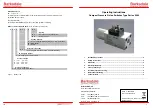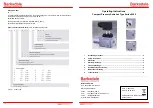
2-19
Catalyst 2350 Switch Command Reference
OL-19055-01
Chapter 2 Catalyst 2350 Switch Cisco IOS Commands
channel-group
Command Modes
Interface configuration
Command History
Usage Guidelines
For Layer 2 EtherChannels, you do not have to create a port-channel interface first by using the
interface
port-channel
global configuration command before assigning a physical port to a channel group.
Instead, you can use the
channel-group
interface configuration command. It automatically creates the
port-channel interface when the channel group gets its first physical port if the logical interface is not
already created. If you create the port-channel interface first, the
channel-group-number
can be the same
as the
port
-
channel-number,
or you can use a new number. If you use a new number, the
channel-group
command dynamically creates a new port channel.
You do not have to disable the IP address that is assigned to a physical port that is part of a channel group,
but we strongly recommend that you do so.
After you configure an EtherChannel, configuration changes that you make on the port-channel interface
apply to all the physical ports assigned to the port-channel interface. Configuration changes applied to
the physical port affect only the port where you apply the configuration. To change the parameters of all
ports in an EtherChannel, apply configuration commands to the port-channel interface, for example,
spanning-tree commands or commands to configure a Layer 2 EtherChannel as a trunk.
If you do not specify
non-silent
with the
auto
or
desirable
mode, silent is assumed. The silent mode is
used when the switch is connected to a device that is not PAgP-capable and seldom, if ever, sends
packets. A example of a silent partner is a file server or a packet analyzer that is not generating traffic.
In this case, running PAgP on a physical port prevents that port from ever becoming operational.
However, it allows PAgP to operate, to attach the port to a channel group, and to use the port for
transmission. Both ends of the link cannot be set to silent.
In the
on
mode, an EtherChannel exists only when a port group in the
on
mode is connected to another
port group in the
on
mode.
Caution
You should use care when using the
on
mode. This is a manual configuration, and ports on both ends of
the EtherChannel must have the same configuration. If the group is misconfigured, packet loss or
spanning-tree loops can occur.
Do not configure an EtherChannel in both the PAgP and LACP modes. EtherChannel groups running
PAgP and LACP can coexist on the same switch. Individual EtherChannel groups can run either PAgP
or LACP, but they cannot interoperate.
If you set the protocol by using the
channel-protocol
interface configuration command, the setting is
not overridden by the
channel-group
interface configuration command.
For a complete list of configuration guidelines, see the “Configuring EtherChannels” chapter in the
software configuration guide for this release.
Release
Modification
12.2(46)EY
This command was introduced.
















































